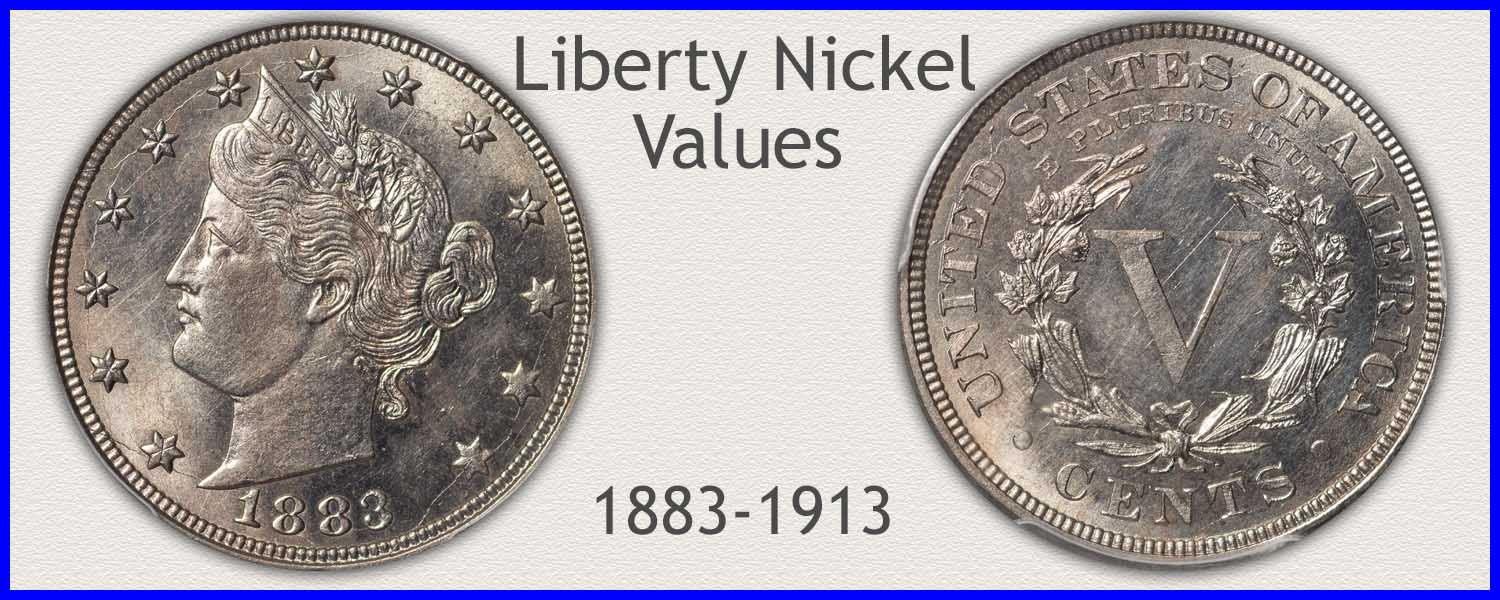Coin Values Moving with Precious Metals: Up-Dated 4/14/2025: Gold $3226 | Silver $31.88
1910 Nickel Value
How 1910 nickel value is accurately determined follows a few defined steps. Liberty nickels are both valued and collected primarily by date. Condition of the coin is next in importance. Depending on a collector's resources, they strive to obtain the highest quality affordable.
The process of identifying how much these nickels are worth focuses on details. Within the coin hobby, the series of the coin, and specific date are highly regarded, and noted. Condition and remaining design details now play a role. Using the steps below and comparing to images helps recognize the key elements needed to complete a valuation.
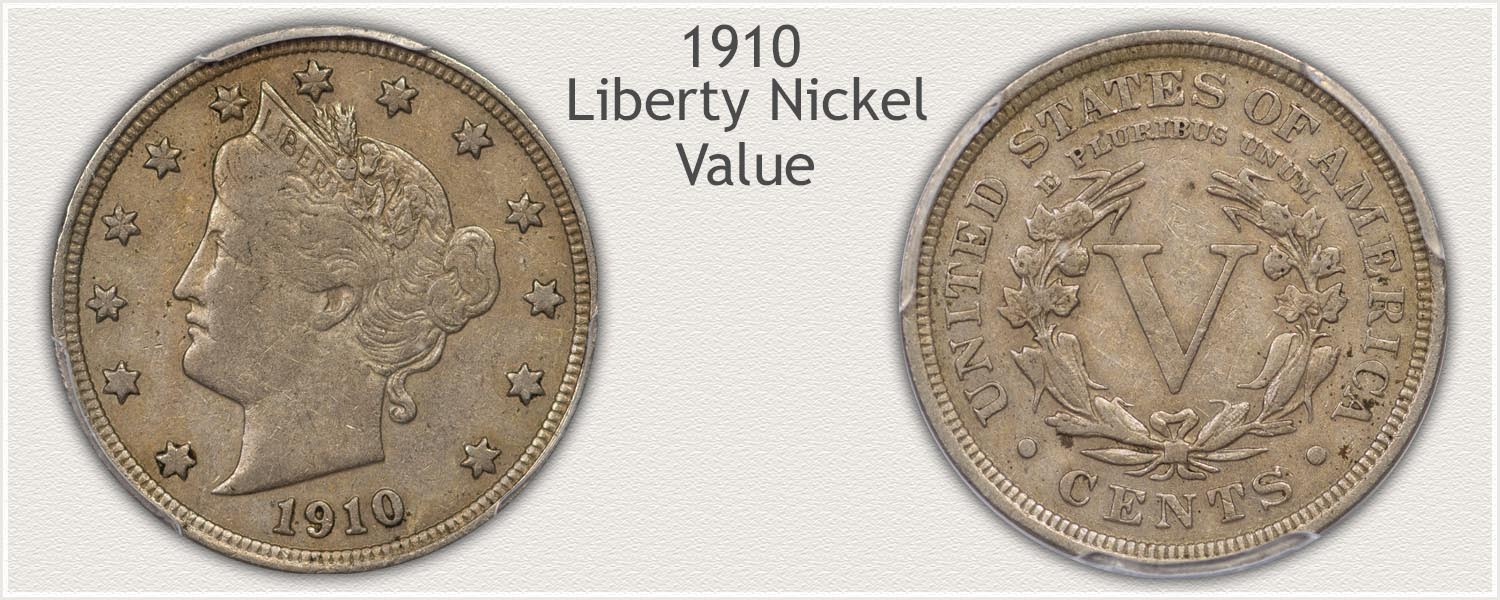
Steps Leading to Value:
- Step 1: Date Identified - Reexamine and record the nickel series and date.
- Step 2: Grading Condition - A comparison to grading images defines and separates the higher premium examples.
- Step 3: Special Qualities - Small visual differences are reviewed to spot potential higher quality.
| 1910 Nickel Value | ||||
|---|---|---|---|---|
| Condition of Coin | ||||
| Date | Good | Fine | Extremely Fine |
Mint State |
| Liberty Nickel Value Updated | 2024 | |||
| 1910 | $1.32 | $3.71 | $24 | $60 |
Listed are wholesale values. These are an average of retail prices used to form a wholesale range. Within each listing above, use it as a guide.
Step 1: Important to Verify Dates on Collectible Coinage
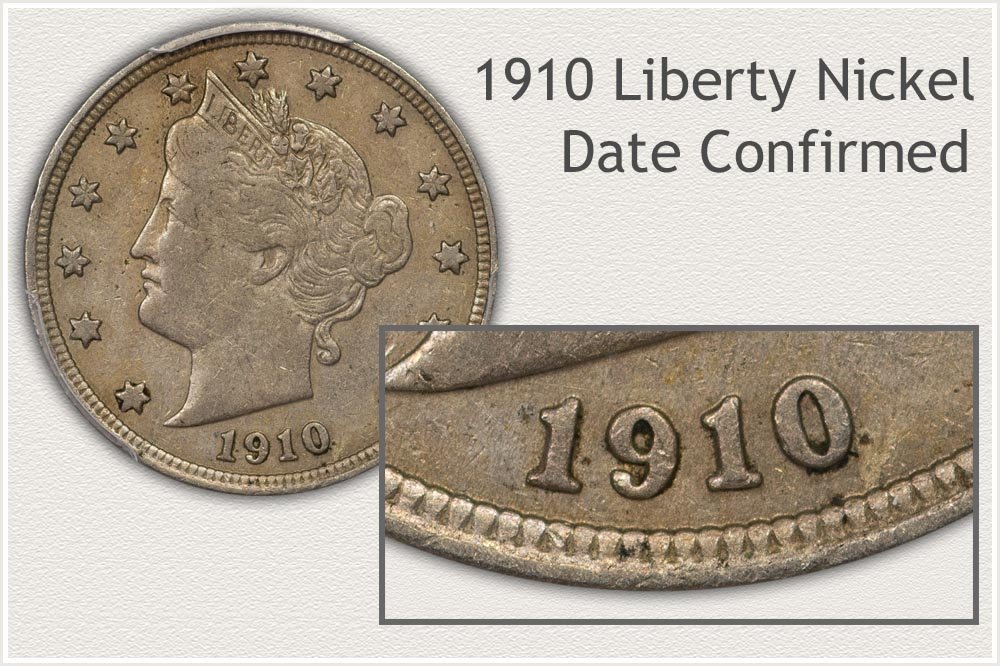
1910 nickels were minted well into the third decade of the long running Liberty design series. By now, production of nickels routinely topped 30 million coins. It was the Philadelphia Mint striking all nickel coinage and producing 30 plus million in 1910. This date is often part of a group of these older nickels and available today in quantities. It is, however, important as part of a complete collection of Liberty nickels.
All dealers, collectors, and value charts begin assessments of coinage by both their series and particular date. Begin with a careful examination of the date.
Step 2: | Grading Condition Identifies Premium Collectible Quality
Images Help Determine 1910 Nickel Value
A coin's condition is visibly displayed on its surface. Grading this condition follows a set of standards defining specific levels of remaining detail. As wear reduces the heights of different design elements, changes such as merging hair strands or missing lettering are gauged. Amount and size of flattened areas and design deterioration determine the difference between heavy and light wear.
Starting with a comparison to images of standard grades, a strong match of a coin's condition begins the grading process. This is then followed by a closer inspection to judge the presence of features needed to qualify at the grade. The descriptions of each grade both define and describe key factors placing a coin within specific grade categories.
These different "grades" are the terms used in the coin hobby as part of a description of coins.
Mint State Grade
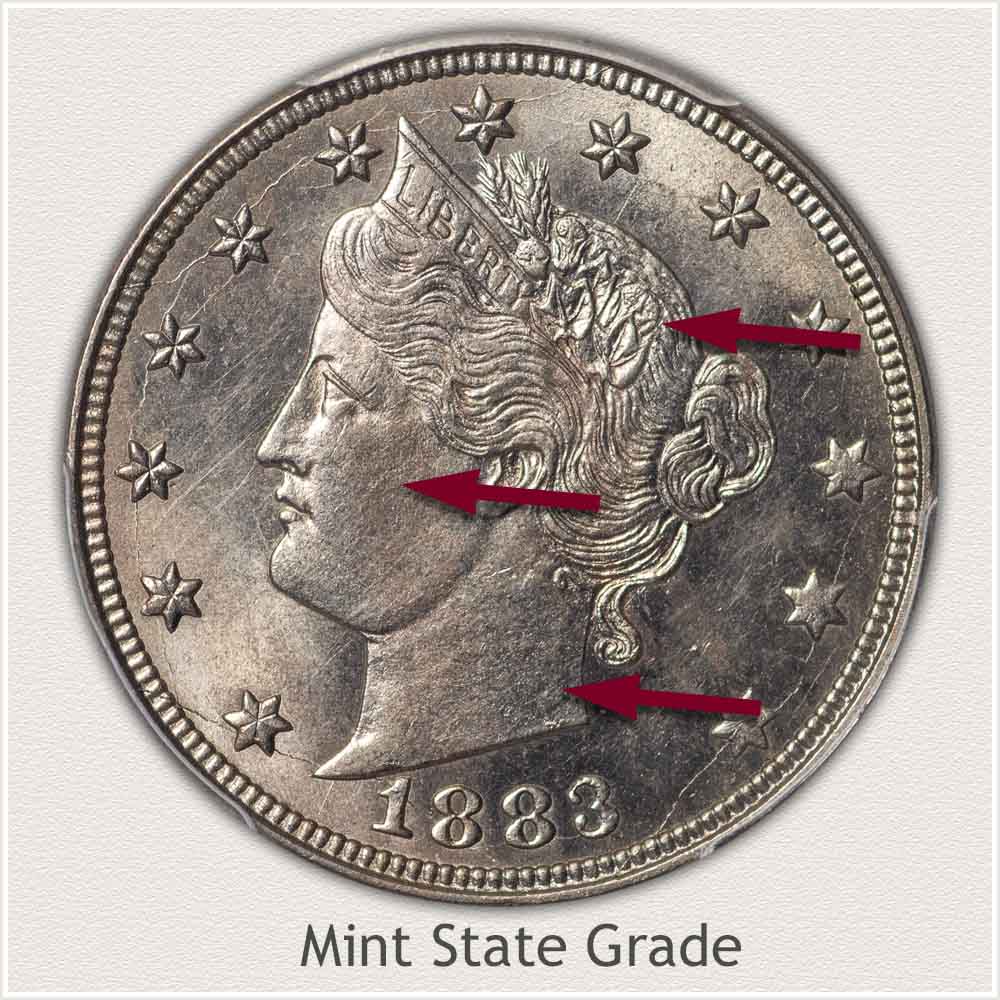
Mint State: The grading term "Mint State" refers to a nickel remaining in a condition with no surface wear. Luster, the shine of the coin, completely covering the surface, is a crucial characteristic to identify when determining this grade. Luster is the sheen newly minted coins display. Handled with care over time, this luster remains intact. As part of the metal's surface, a fine grain texture is imparted during the striking process, giving the coin its luster. Luster quickly fades when a coin is in circulation due to the delicate nature of its texture.
Just above the date, Liberty's neckline and then further up, her cheek, are important features to judge. Raised well above the field, open, and contoured, are similar features of both areas. Time in circulation smooths the surface, eliminating the texture and replacing the luster with a soft gray color to the metal. Shine and texture of Mint State coins are similar across both high reliefs and low protected areas. Compare her cheek to the area beneath her ear.
The fine lines in high relief on the design are examined further as part of the evaluation. The edges of the cotton leaves above her ear are fully rounded, with no evidence of smoothing or flatness. In addition, the delicate hair detail behind her ear shows no signs of smoothing. Examine the coin's surface from different angles to "see" if the shine remains intact with no breaks in the luster.
Extremely Fine Grade
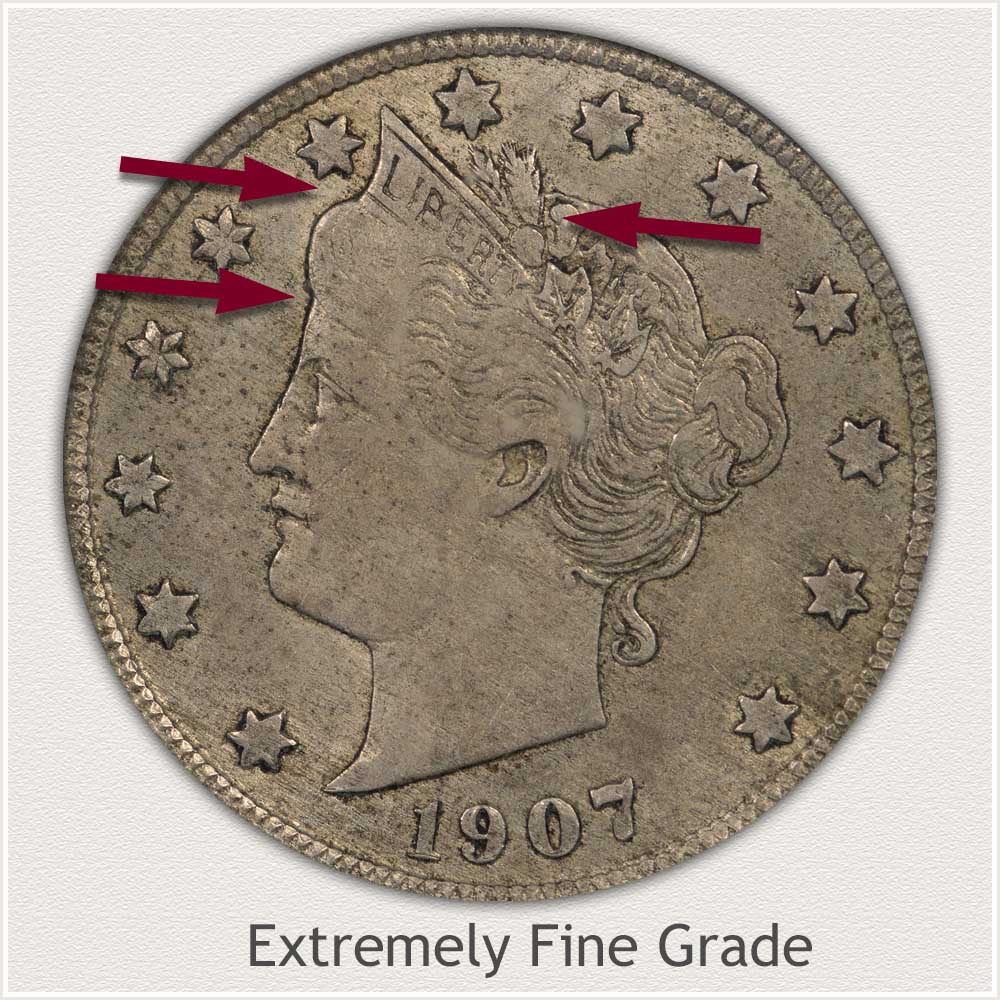
Extremely Fine: It is a strong indicator that wear has now covered the coin's surface when the bright shine of luster is gone and replaced with a smooth gray tone. The Extremely Fine grade is distinguished by only minor flattening areas caused by wear. Within the design, there is only a slight smoothing of high-profile points.
Liberty's hair still has many of its fine lines visible and distinct in order to receive the grade. Only a few missing and merged lines and a small amount of wear is visible just above her forehead. To achieve this high level of condition, the overall appearance displays as clear and sharp.
All letters in the word "Liberty" are fully readable in the example image. This headband and lettering is a high relief feature of Liberty's design and essential to remain sharply detailed for the grade. The band's upper and lower edges are both visible. Additionally, in order to achieve the high quality and appeal necessary for the grade, bold letters are a requirement.
Fine Grade
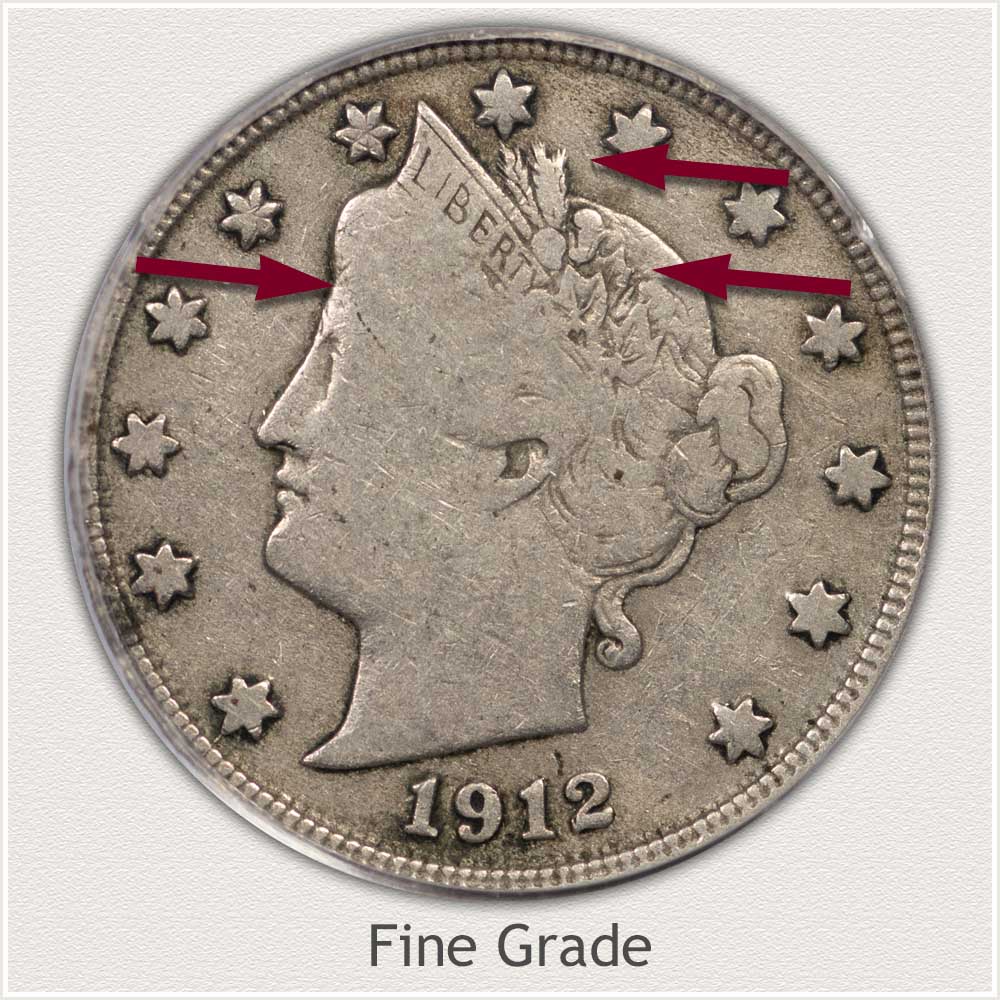
Fine Grade: This 1910 nickel displays excellent detail and earns the designation of Fine Grade, placing it squarely in a collectible category. The condition is defined by a pleasant distribution between light to moderate wear and abundant detail.
Above Liberty's headband, the deeply recessed features, letters, and wreath, remain well detailed. Cotton bolls and leaves, as well as wheat grains rising above her head, are easily identified. When combined with a large number of hair strands visibly well defined, all of these elements give the design an appearance of high quality.
It is important and necessary to have full lettering of "LIBERTY" on the headband. While the lower edge of the band is missing or faint in some areas, the upper line is complete and strong. Hair and her forehead are separated ever so slightly, this is enough to recognize the coin's grade as Fine, and a nice collectible nickel.
Good Grade
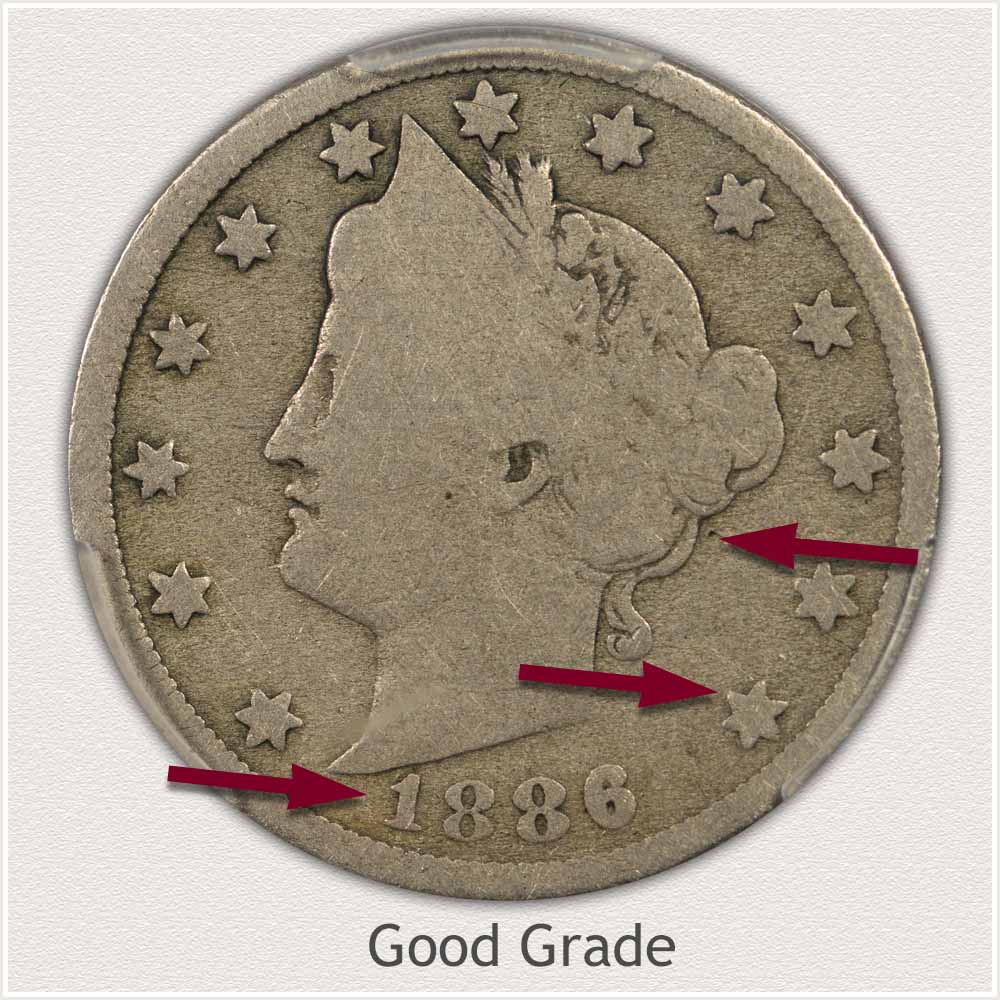
Good Grade: A heavily circulated Liberty nickel is recognized when Liberty's portrait is now only an outline. One minimum requirement of the condition is outlines of major features remain complete. Confirming a full portrait is first, followed by judging the raised stars, date, and rim.
Inspecting Liberty's portrait, finds it is still complete with no fading into the field. Although, worn smooth and the lack of minor details showing within the portrait is limiting the grade. When compared to the front if the portrait, the back of her head is often weaker. A close inspection is made to determine any fading of detail into the field. Note in the image boldness to the edges of Liberty's outline is evenly balanced across the entire portrait.
Stars along the inner edge of the rim meet the quality of a Good condition coin due to their completeness and rising bold from the field. It is typical of the Liberty nickel series for some stars to remain bolder than others due to depth of the original impression. An essential feature of the grade is a complete date, distinct, and disconnected from the rim. In addition, it is important the inner edge of the rim is entirely continuous without any fading along its perimeter.
A Liberty nickel displaying heavy but balanced wear, along with full outlines to major features still presents a quality look. This older nickel series is of interest to collectors when all features are clear of the background.
How to Video: Grading Liberty Nickels
Areas on the reverse of these Liberty nickels are further examined when judging their complete condition. When viewing the video, attention is given to subtle features key to reaching higher grades.
Grading Liberty Nickels | How to Video and Descriptions
Step 3: | Special Qualities | Positive Features Adding Appeal
Recognizing and Separating Above Average Appealing 1910 Nickels
Here is a special date of the Liberty nickel series attracting collectors. 1910 nickel value ranges from low, affordable choices suitable to new/starting collections. Mid-range condition examples are readily available to a more involved set of collectors. Continuing to high quality, an ample supply of upper condition pieces also remains, these enjoy a strong demand from advanced collectors.
With an initial production recorded at over 30 million, supply was ample at the time, and many remain today in all states of preservation. Enough were saved, and demand is balanced, resulting in a nice collectible, representing this now older Liberty nickel design series.
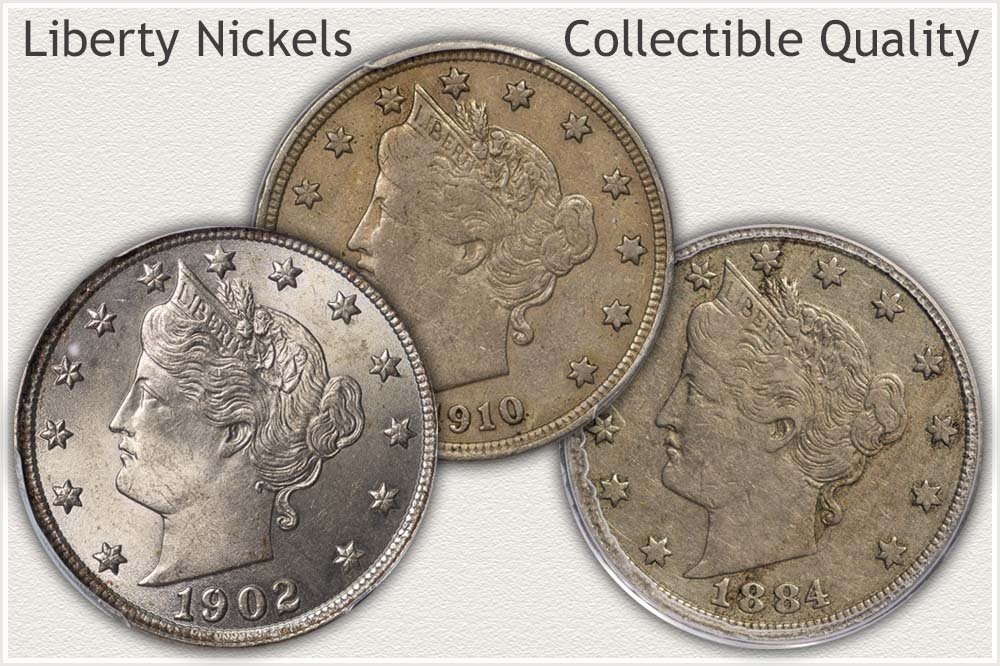 Liberty Nickels Selected for Pleasing Qualities
Liberty Nickels Selected for Pleasing Qualities
The above coins are notable as pleasingly well struck, with natural and original toning, and free of noticeable marks.
Recognizing special qualities in any condition identifies and separates the above average looking coin within each grade category. This is where eye appeal is becoming significant. Qualities important to observe is a balanced appearance of remaining detail. An overly worn side of the coin is less desirable. This is one of the properties of the Liberty series, uneven striking, often shows on worn coins, with stars very weak in the area behind Liberty's portrait.
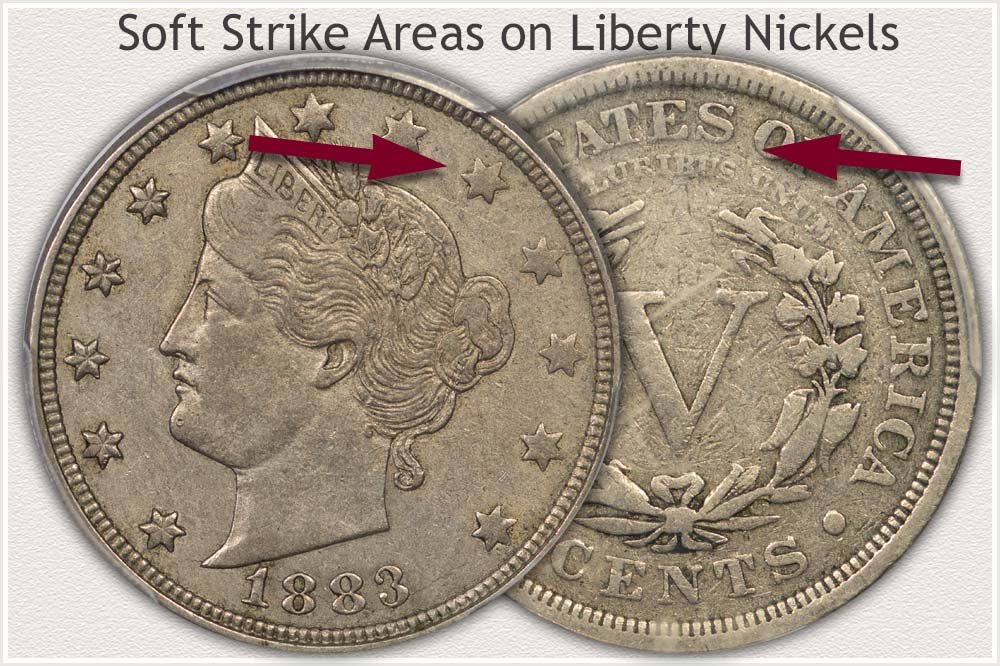 Softly Struck Areas on Liberty Nickels
Softly Struck Areas on Liberty Nickels
Additionally, the reverse of the coin often displays a softness to the motto "E PLURIBUS UNUM" In the original design, lettering of the motto is less raised from the field. Since it is tucked under the legend, any lessening of a strong impression when minting, causes the motto a slightly faded appearance. This weakness shows on coins with moderate circulation wear. Sharp and crisp is the less often condition of the area.
With many examples to choose from, smaller detail considerations become involved when deciding on quality. Taking eye appeal to greater extent, collectors notice the lack of detail on the center of stars and the depth/strength of the motto on the reverse. Boldness in these areas is an upper quality example of the grade.
Review these areas on all dates of Liberty nickels as an indication of strengthening the judgment of condition and market appeal. A strong, balanced strike on both sides of the coin sets these apart from the majority.
References
U.S. Mint. 1911 U.S. Mint Annual Report
https://nnp.wustl.edu/library/book/323
U.S. Mint. Catalogue of Coins of the United States.
https://nnp.wustl.edu/library/book/554591
Coin Values | CoinStudy Articles
Date by Date
In Depth Liberty Nickel Values
1883 to 1912
The Value of V Nickels | A Series with a Wide Range in Rarity
Popularity of the Liberty design nickels is steady, to growing. Value chart listing all dates and mints shows the demand for scarce issues and grades. Early years are rising in value, especially in higher collectible condition.
Coin Grading Services | Professional Judgment of Authenticity and Grade
Often having these higher value coins evaluated and graded by one of the top two services improves their market acceptance. With the steep rise in value moving up the grading scale of 1910 nickels, any coin worth over one hundred dollars is a candidate. Review the services helping to decide.
Print the Coin Values Worksheet
A printable sheet to organize important information about coin holdings. List descriptions and values starting with your Liberty nickels, and add all coins as they are evaluated.
Grading Old Coins | How to Videos:
Condition is important to all U.S. coinage. From the classical series to the current, videos and additionally descriptions point to key features helping recognize the stage of condition and apply a grade. Review the index of how to grade the different series.
★Coin Values Discovery finds 1910 Nickel Value and...
Charts covering Coin Values. Start here with a step-by-step method used to narrow a range of how much old coins are worth. All series [series and denominations] of coins are covered with value charts, images to confirm dates, mintmarks, and condition. These are the key features of a complete evaluation.
